Josh, Thanks for sending me the photo!
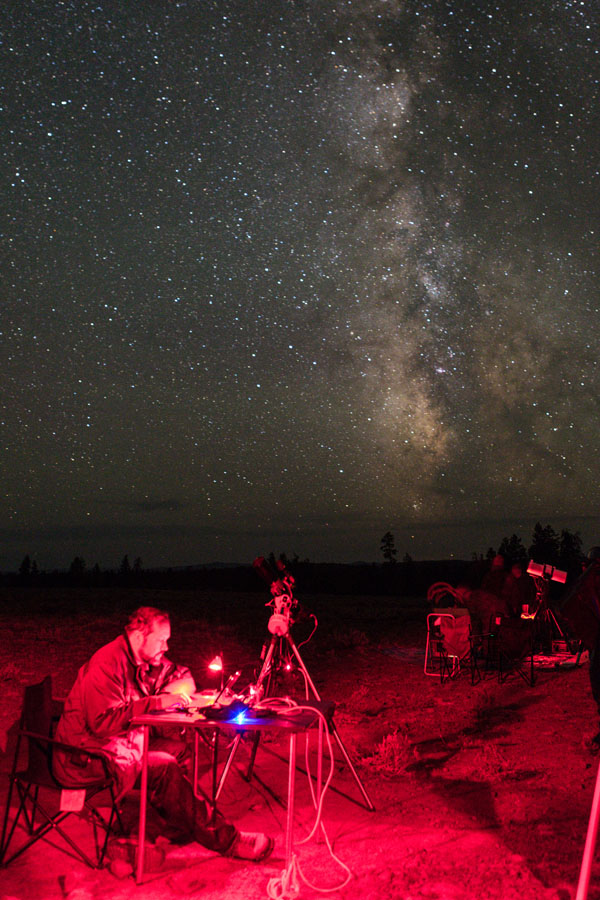
When you want to see the stars, find someplace dark
The plan is simple, a vacation combining a visit to my family and a run to Oregon Star Party. I miss doing the larger regional star parties, six telescopes is a big star party on the island. OSP would feature hundreds of telescopes, speakers, and hopefully dark skies. I also volunteered as a speaker, may as well bring and share little Keck experience.
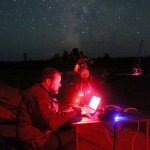
The site is quite remote, no nearby hardware store to replace a missing bolt, no internet connection to allow download of a missing driver. The setup would have to work with what was packed to start with. Several iterations of packing showed that two cases would be required to carry the setup. An ancient hard suitcase I have had since my Air Force days, and a hard equipment case purchased years ago for a portable telescope I have yet to build. At least both had wheels and could be hauled by one person through an airport terminal.
After a few very nice days visiting with my parents I steal away in the camper for the drive to OSP. Four hours sees me over the Cascades, into the Ochoco Mountains east of Prineville. It is a very pleasant drive, a beautiful day, open roads, Mt. Hood soaring over the trees that line the highway. The sort of driving you just can not do on the island, the sort of vacation I grew up with.
The Southern Delta Aquariid meteor shower will peak this weekend. This reliable shower usually produces 10-20 meteors per hour. The peak will occur on July 27th this year. As the shower has a broad peak there should still be a good showing a few days either side of peak.
As we are past new Moon there is some dark sky available in the evening, best viewing for this shower is in the morning, when a bright 60% Moon will rise. Moonrise will occur around 22:00HST on the 27th and 22:43 on the 28th. The radiant for this shower will rise at 09:22HST. This provides a slim window of darkness to attempt meteor viewing. After rising, the moonlight will dim the prospects for viewing the shower.
Another site that allows an amateur astronomer to take advantage of the pristine skies of Mauna Kea is located next to an electrical substation just a couple hundred yards east of the Mauna Kea Visitor Information Station. Here you can enjoy a truly spectacular sky above the tropical haze and VOG of lower elevation Hawaiian locations. Far from the modest lights of Kona or Hilo there is almost no light pollution and the tropical inversion layer often keeps the clouds and rain well below this mountain site. While the site may see some early evening use by sunset watchers and possibly a tour van doing a star tour for their guests the majority of the night will offer an escape from the crowds across the road leaving the observer alone to enjoy the universe.
View Larger Map
The Substation site has some advantages and some disadvantages…
The VIS is more sheltered as it is below the small ridge and offers a somewhat better southern horizon.
The site is easily found by turning off the main road just below and opposite the entrance to the Mauna Kea VIS. A break in the guard rails provides access to a short gravel road that proceeds straight up the hill to the saddle and the substation.
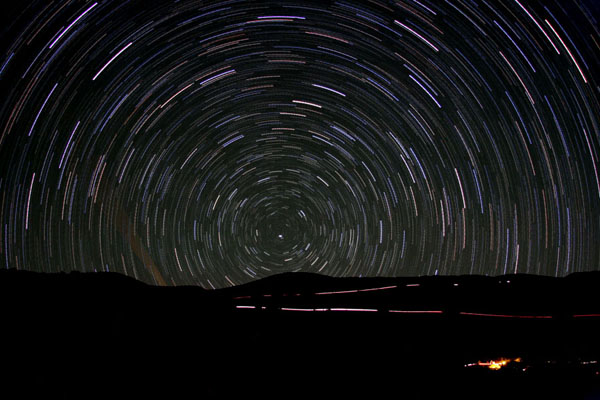
Presenting the wonders of the night sky to the general public can be a rewarding experience. The smile on a child’s eyes they first time the see the rings of Saturn or the craters of The Moon is a truly a wonderful thing.
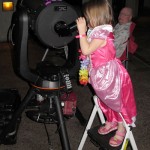
I am attempting to put down a few of the things I have learned in over a decade of hauling a telescope around. In that time I have used countless schoolyards as observatories, set my gear up at posh resorts, on the tee line of a driving range, outside the front door of Wal-Mart, across the fence from cows at a dude ranch, parking lots, city sidewalks and grassy lawns, under conditions both perfect and absolutely lousy for doing astronomy. Dealt with everything from drunks to two year olds, and I still do this regularly… It is worth every young smile!
A line of big telescopes greeted the crowd. Mike had his 20″, Cliff his 24″, my 18″ Deep Violet, later in the evening Olivier set up his 18″ Priscilla. All of this large glass was open to the public, we each had long line of folks waiting a turn at the eyepiece. It was a huge Saturday night crowd, several hundred people awaited darkness. Yes, I had made the decision to observe from the VIS, knowing that there would be a crowd, but wow!

Showpiece objects, the Andromeda Galaxy, The Pleiades and Jupiter were available for viewing. I was stuck on the Orion Nebula all evening long. I changed targets once, to meet a chorus of request to move back to the nebula. I have to admit it was a pretty view, even to me, who has seen this sight more times than I remember. I put the 35mm eyepiece in place, creating a bright low power view that had visitors waiting through line a few times for second and third looks.
In addition to the big dobs there were quite a few smaller ‘scopes present. Maureen had her C-11 setup, Larry brought his nice Stellarvue 102mm refractor, Mike had an 8″ SCT beside his 20″ for use by a friend. Dan didn’t bring a ‘scope, but he did bring pizza! We met Woody, an Alaskan Airlines pilot flying the Anchorage to Kona run. Out of a couple carry-on sized bags he produced more telescope than we would have thought fit in airline luggage…. A neat collapsible pier arrangement with an alt-az mount and a very nice WO 110mm APO.
I have spent quite a few hours lately revamping my observation database. The whole thing had been quite neglected as of late, never being properly updated since I changed over to WordPress on the main blog. The appearance had been left in a halfway state that didn’t match anything, never mind some serious bugs.

The printable version is still there, a clean black-on-white layout including inverted DSS images for printing. I took a cue from that printed version and kept the other new layouts very clean and uncluttered in appearance.
There is a nearby object section that picks up any close by objects for quick reference. Some attention has been paid to the search routines for better usability.
Those are just the visible changes, much of the work has gone into the back end to improve the quality of the underlying data. The whole thing uses Python and Tk on my local machine, this gets converted to SQL and PHP for the webserver. Most of the tools are automated at this point, and getting less buggy as I hunt down the little issues that I find with use.
I put the whole thing together for my own use, a place to organize my observing notes. But as it is online, anyone can use it. Let me know if you ever find it useful.
Star parties at Hale Pohaku are very informal affairs. You never really know who is and who is not going to show up. We just don’t plan that much.
It had just been too long, I had not had a good night out with the telescope for months. This dark moon Saturday was not going to be missed, I packed up Deep Violet and headed for The Mountain. I knew a few folks would be there, certainly Cliff and Tony. The rest of the folks were a surprise to me. As the evening progressed more and more ‘scopes showed up, a few more familiar voices in the darkness.
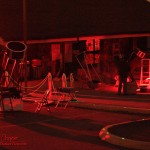
The only real issue was the wind, it was annoying. A couple of us moved our telescopes into the patio area of the MKVIS, where the building offered some shelter at the expense of blocking some of the sky.